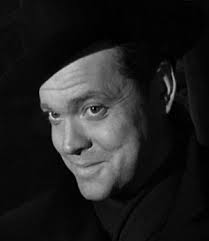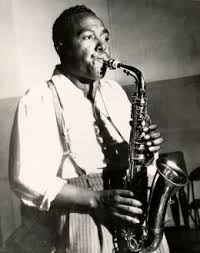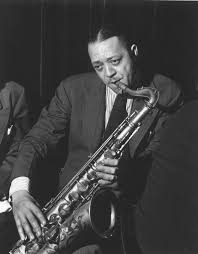A Little Evil Will Do You Good: Kansas City Jazz
by Con Chapman
In the film The Third Man, Orson Welles plays Harry Lime, a black marketeer in post-World War II Vienna.

Orson Welles as Harry Lime
When he is confronted by his friend Holly Martins, Lime excuses his misdeeds with a speech that Welles himself contributed to Graham Greene's screenplay. “In Italy,” Lime says, “for 30 years under the Borgias they had warfare, terror, murder, and bloodshed, but they produced Michelangelo, Leonardo da Vinci, and the Renaissance. In Switzerland they had brotherly love—they had 500 years of democracy and peace, and what did that produce? The cuckoo clock.”

Joseph Cotten as Holly Martins
While the requirements of dramatic tension compelled Greene to make the results of Lime's crimes as horrible as possible—children crippled by meningitis they contracted due to his diluted penicillin—the principle pronounced by Lime has a curious element of truth to it. Consider not the Borgias' Italy, but Kansas City, Missouri.

Tom Pendergast
From 1925 to 1939, Kansas City was ruled by “Boss Tom” Pendergast, a Democratic politician who allowed alcohol to flow freely despite Prohibition, and who averted his gaze from (and no doubt profited from) illegal gambling. Pendergast achieved Sadam Hussein-like victory margins by a combination of payoffs, fraud and intimidation. Under his rule, the bars never closed and musicians jammed all night long and into the morning. The neighborhood that fanned out from the intersection at 18th and Vine became known as a reincarnation of Storyville, New Orleans' red light district where live music was the come-on to more intimate pleasures during the infancy of jazz.
There developed out of this ever-simmering heat—like a barbecue pit that never went out—a distinct Kansas City sound that changed the course of American music at the same time that it gave birth or schooling to jazz masters such as Lester Young and Ben Webster on tenor sax, and Charlie Parker on alto.

Bennie Moten, by R. Crumb
Claude Williams, a violinist who played with Andy Kirk's Twelve Clouds of Joy, summed up the competitive nature of those all-night cutting sessions thusly: “Kansas City was different from all other places because we'd be jamming all night. And [if] you come up here . . . playing the wrong thing, we'd straighten you out.” The story is told that the first time Charlie Parker got up at such a session to take his licks, his failing grade was communicated to him by the drummer, who crashed a cymbal over on him to tell him to get off the stage. A guild of musicians with the chops to tell Parker—the most protean improvisator of the bebop era—to come back when he's ready is one tough union.

Charlie Parker
For the most part the Kansas City sound was a product of musicians born in the central or southern midwest; Bennie Moten, Parker and Webster (Kansas City Kansas or Missouri); Jay McShann (Oklahoma); Andy Kirk (Kentucky); Hot Lips Page (Texas); Lester Young (Mississippi); Walter Page (Missouri). But it began to reach a greater share of the nation's ears when a transplant from the east coast—Bill “Count” Basie—collected several personnel from Bennie Moten's band following the latter's death in 1935. John Hammond, who would later discover Bob Dylan and Bruce Springsteen among others, heard a short-wave radio broadcast of the band from New York and went to Kansas City to check them out. He described their 1936 sessions for him—the first on which Lester Young was ever heard—as ”the only perfect, completely perfect recording session I've ever had anything to do with.”

Lester Young
The Kansas City sound moved at a loping gait—a 4/4 beat rather than the 2/4 time that had characterized jazz recordings up to then. Kansas City bands often played according to so-called “head arrangements,” communal affairs composed and arranged collectively, changing every night on the fly, rather than sight-reading composed music. (Basie's band began to go downhill musically once it was financially successful enough to purchase the services of outside arrangers.) Finally, Kansas City jazz was a counterpoint of “riffs,” with one section playing a repetitive, rhythmic line behind a vocalist to add energy, or two sections—sax vs. trumpets—alternating and competing with each other, driving the music without exhausting it.

Jay McShann, leader of the first band in which Charlie Parker played
Could Kansas City jazz have evolved without vice and corruption? Perhaps, although it was a wide-open laissez-faire attitude towards man's ineradicable taste for forbidden pleasures that brought it to a boil. Where moral strictures are tight, art tends to wither. You won't find any jazz of consequence in Utah, for example, even though that's the name of their pro basketball team.
I'll bet it's a great place to shop for cuckoo clocks.
|
2
favs |
1666 views
5 comments |
851 words
All rights reserved. |
Author's Note
The author has not attached a note to this story.
Other stories by Con Chapman
Tags
This story has no tags.
this is very cinematic--both in its language and structure--it's exciting the way you intersperse photographs within this narrative *
Thanks. KC's contribution to jazz is mostly forgotten now.
Entertaining as ever, and thought provoking, too. Great ending.
Instruction and delight.
*
Ever see "The Phenix City Story"? Corrupt town. Sin aplenty but no art.
Corruption without art I'd vote to stamp out. Corruption with art . . . I'll consider.